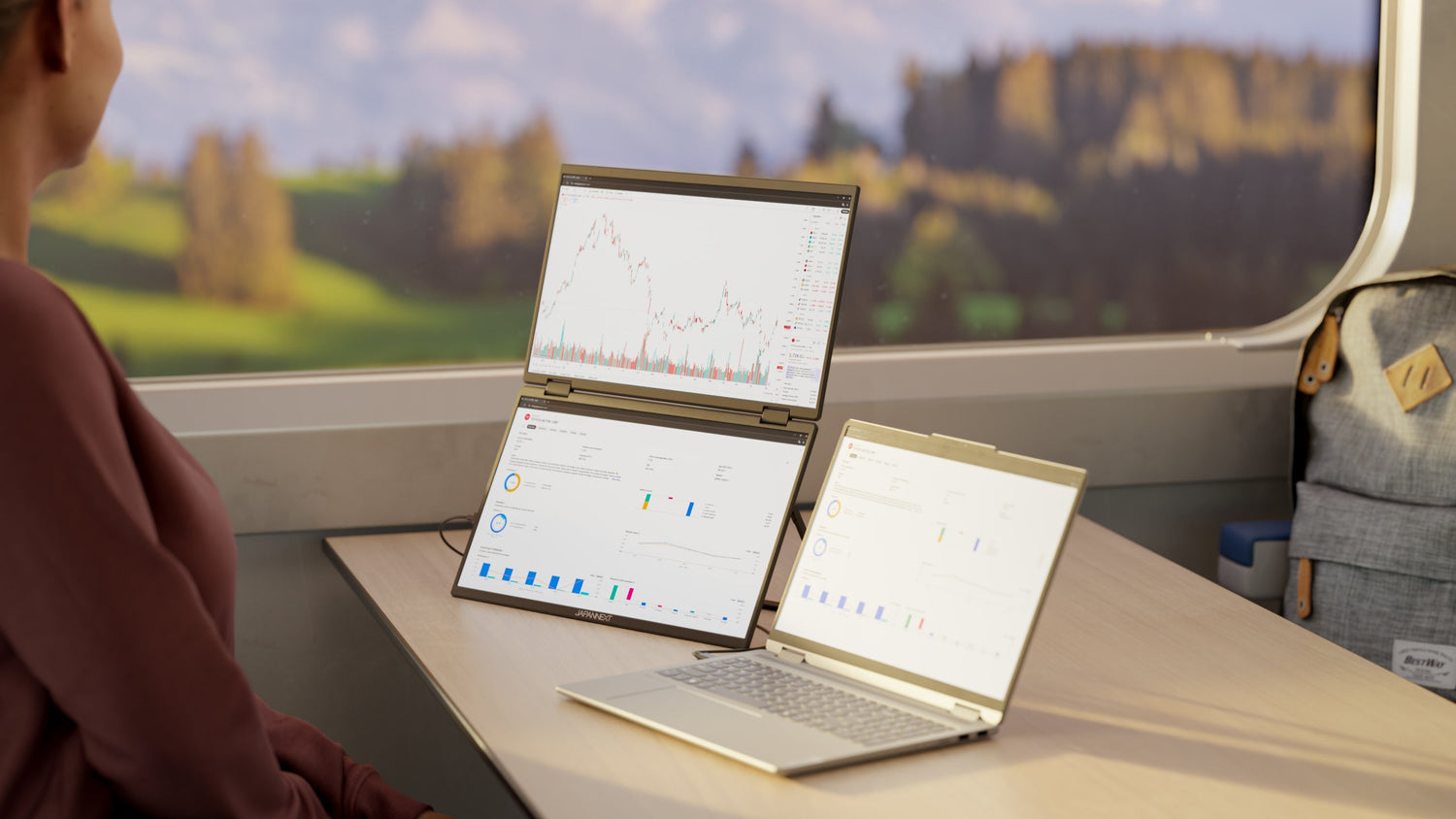At Japannext, we have received a lot of questions about using large format monitors in a professional set up. So we are happy to answer!
In a world where productivity at work has become a priority, the tools used can make all the difference. One of them, often overlooked but extremely relevant, is the widescreen monitor. In particular, ultra-wide monitors are revolutionizing the way we work and interact with our digital workspaces. Let's explore together how these large monitors can optimize space management, improve visual comfort and reduce eye fatigue.
Optimization of workspace management
Multiple windows and documents open simultaneously, with a wide screen, it's easy
A major advantage of ultra-wide monitors is their ability to manage several windows and documents at the same time without having to be limited to a system of reduced or juxtaposed windows. By opening different applications side by side, we will significantly reduce the number of trips between them, thus increasing performance and the time spent on important tasks.
- Emails on one side and spreadsheet on the other
- Browser with searched resources and writing document open simultaneously
- Videoconference discussion on one half of the screen, notes or presentation available on the other half
Better visual organization
The expanded display configuration also allows for better visual organization. Icons, widgets and shortcuts can be arranged in a more logical and accessible way, making navigation simpler and work smoother. Other components like toolbars can remain constantly visible without encroaching on the central workspace.
Improved visual comfort
Curved monitors: total immersion
Ultrawide monitors are often available as curved, which improves immersion and reduces the need for excessive eye movements. These features help maintain a uniform distance between the eye and each point on the screen, creating a more natural and pleasant viewing experience. This directly contributes to visual comfort, making long work sessions less strenuous.
Reduced eye fatigue
Another essential aspect is the reduction of eye fatigue. With a widescreen monitor, the need to squint or lean forward to read small fonts is eliminated. Users can adjust resolution and brightness settings to perfectly meet their specific visual needs, further contributing to a significant reduction in eye fatigue.
Impact on professional productivity
Easy multitasking
Having a very large monitor undeniably promotes multitasking. Studies have shown that employees working with such devices complete their tasks faster and more accurately. The ability to keep tabs on multiple aspects of a project without constantly switching windows improves overall efficiency.
Increased collaboration
During meetings or collaborations, having an ultra-wide monitor makes it easier to share detailed and complex information. A diagram or statistic can be displayed while still providing space for taking notes or reviewing additional documents. This flexibility greatly enriches professional interactions.
Saves time and lowers costs
Less equipment needed
With a single widescreen monitor, the need to purchase multiple monitors diminishes. This aspect not only benefits office space management but also costs. Fewer devices performing the same task frees up physical space and reduces messy cables.
Simplified setup
Setting up a workstation becomes faster with a single high-performance wide screen. Dual or triple monitor setups often require extensive adjustments and constant adjustments, while an ultrawide monitor minimizes this complexity.
Use in different professional fields
Graphic design and video editing
For professions requiring meticulous attention to visual details, a widescreen monitor is essential. Graphic designers can observe their creations in detail and simultaneously make corrections or retouches without losing contextual visualization.
Financial data analysis
Financial analysts and other professionals dealing with a lot of data also benefit enormously from ultra-wide monitors. Spreadsheets can be viewed in their entirety, and graphs and comparison tables can be viewed side by side for a complete overview.
Software and IT development
Computer developers find large displays a valuable tool. Source code can be viewed in its entirety while test environments, debugging consoles and related documentation are easily accessible without constant switching between windows.
Adjusting to new work trends
Work from home and home office
Working from home as become a standard in the last few years for most companies, so having a large monitor at home becomes crucial to maintain a working environment close to the office. This helps support creativity and ensures that performance is not compromised by hardware limitations.
Shared offices and hot desking
In modern offices adopting hot desking practices, work areas equipped with ultra-wide monitors can serve different employees throughout the day with equal efficiency. Versatile equipment then meets varied requirements while ensuring a flexible and productive working environment.
Some examples of large format monitors
34-inch curved monitor : with this curved monitor equipped with an IPS panel and UWQHD (3440x1440) resolution, you will find all the technologies necessary for office automation and viewing multimedia content: HDR, PIP, PBP, KVM, recharge your computer via USB-C to avoid accumulating cables on your desk.
37.5-inch curved gaming monitor : a must-have for gaming with its IPS panel, 1ms response time and UWQHD+ (3840x1600) resolution.
Large format 50-inch monitor : this 4K monitor can be used as a dynamic display, television, or presentation display in the professional environment.



